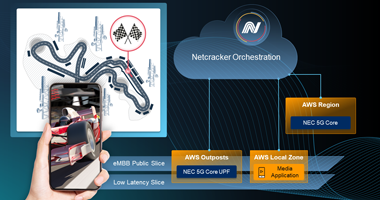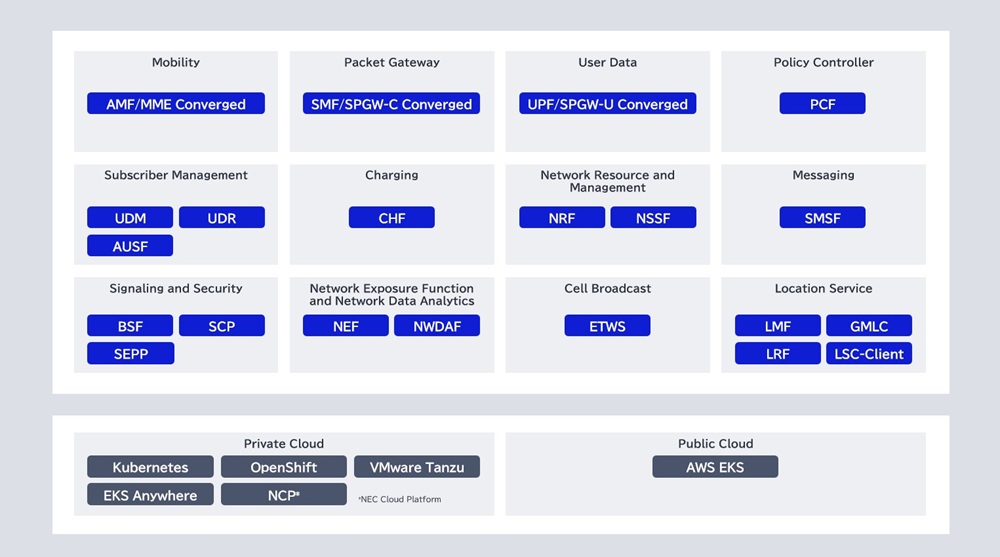Global Site
Breadcrumb navigation
NEC Open Networks
Converged Core
4G/5G Converged Core


-
Overview
5GC (5G Core) is a mobile core network system designed to support 5G radio access networks.
NEC‘s 5GC features a highly open, cloud-native architecture that enables the use of 4G EPC functions within the 5GC framework. Its multi-platform design is compatible with both on-premises deployments and public cloud environments, offering a proven, high-performance software-based UPF (User Plane Function).
It is a mobile core solution that offers global deplorability, flexibility, compatibility, high performance, and high quality.

Features
NEC's 5GC provides a solution with the following features.
Fully Cloud-Native Converged Mobile Core
NEC 5GC’s architecture is a fully virtualized and containerized microservices architecture.
It supports multi-vendor environments and is not dependent on hardware.
Users can choose from a wide range of platforms, including private clouds, public clouds, and hybrid cloud environments. Multiple deployment architectures can be selected based on business needs.
UPF can also be provided via AWS Outposts, enabling seamless integration with AWS-managed services and achieving ultra-low-latency connections in on-premise environments.
Flexible UPF Local/Edge Model
With the separation of C-Plane and U-Plane(CUPS), NEC's 5GC enables the construction of flexible and powerful network architectures.
Multiple U-Plane deployment options, such as cloud-based network solutions and U-Plane devices in hardware-provided models, allow for the adoption of a UPF solution tailored to specific use cases. Additionally, the solution can accommodate various hardware requirements, such as compact footprint devices. For example, it enables quick commercialization for agile use cases like Private 5G.4G EPC available on the 5G Core
Seamless migration from 4G to 5G is supported in both NSA (Non-Standalone) and SA (Standalone) architectures.
NEC 5GC provides a unified, consistent interface for the maintenance and operations of both 4G and 5G networks. It handles 4G/5G traffic comprehensively and can flexibly distribute resources according to the traffic ratio of 4G/5G.Proven Software UPF Performance
The UPF is software-based and available on general-purpose servers.
Software-based architecture provides high adaptability to the evolution of hardware. This allows for the continuous delivery of high-performance UPF solutions.
It supports both 5G UPF functions and the U-Plane for 4G Gateways.
NEC's 5GC solution
The diagram illustrates the network functions (NFs) supported by NEC's 5G Core (5GC).
It comprehensively covers essential areas indispensable for the deployment and operation of 5G services, including core functions such as mobility control, session control, and the user plane, as well as cell broadcast and positioning services.
Additionally, NEC 5GC features Converged functionality, enabling the unified processing of both 4G and 5G traffic within a single software solution. This feature enables a simple and gradual transition from the existing EPC system to 5G infrastructure.
All NFs are delivered as containerized microservices and have been rigorously tested across Kubernetes, OpenShift, and major cloud platforms including AWS EKS. Designed for flexibility, they can be deployed across a variety of environments—on-premises, private cloud, public cloud, and hybrid cloud configurations—allowing for network designs that range from centralized to edge-distributed, tailored precisely to customer requirements.
Benefits of the 5GC solution

Profitability
Creation of New Revenue Opportunities through High-Value Services
Expectations for mobile networks have evolved from merely providing connectivity to generating revenue through advanced services. The DPI (Deep Packet Inspection) capability integrated into NEC UPF identifies the types of traffic and applications, enabling prioritization of bandwidth for specific applications and the implementation of flexible pricing policies.
Improving Profitability through Enhanced User Perceived Quality
Mobile networks consist of various interconnected networks—such as RAN, transport, and core networks—that collaborate to provide communication services. These networks face the risk of declining user perceived quality due to differences in network speeds and congestion conditions. In particular, within RAN, fluctuation of radio waves and the density of users within the area can cause deterioration in communication quality.
NEC‘s TCP Optimization enhances profitability by intelligently controlling the density of data sent from the core network in response to RAN congestion conditions. This optimization improves RAN resource efficiency, helps reduce investment in base stations, and enhances users’ service experience. As a result, it contributes to the financial performance of telecom operators.
Scalability to Address Demand Fluctuations and High Business Continuity
Preparing for natural disasters and sudden traffic surges requires ensuring the flexibility and availability of networks. NEC‘s 5GC, with its hybrid cloud architecture, enables rapid utilization of cloud resources to restore services during disasters and dynamically adjusts resources during normal operations based on demand fluctuations. This features strengthen business continuity while enabling efficient resource utilization.
Building an Open and Flexible Network
With growing interest in open network architectures, multi-vendor system configurations have become a key requirement. NEC's 5GC offers platform flexibility, allowing for optimal utilization of existing infrastructure. It reduces dependency on specific vendors, enhancing both the scalability of services and operational flexibility.
Scalability
Automated Network Management
To address labor shortages and rising operational costs, the demand for automation in network operations is surging. NEC's 5GC EMS is optimized for public cloud environments, minimizing human intervention both on-premises and in the cloud. It helps not only reduces operational costs but also prevent human errors.
Power Efficiency for Reduced Environmental Impact
Increasing environmental awareness and Total Cost of Ownership (TCO) reduction are critical challenges in network operations. NEC supports both ARM processors and Intel E-core-based CPUs to significantly reduce the number of 5GC servers and power consumption. This approach lowers environmental impact while optimizing electricity costs.
Simplified System Architecture
NEC's UPF can be operated on a streamlined infrastructure system—NEC Cloud Platform (NCP)—which integrates hardware monitoring and control functions, as well as lifecycle control, configuration management, fault monitoring for NFs. Compared to complex configurations involving multiple systems, this simplification enables significant reductions in operational costs.
Efficiency
Why choose NEC?
Extensive Experience and Proven Track Record in Communication Infrastructure
Since the era of switching systems, NEC has been providing products and solutions to support communication infrastructure. The cloud-native 4G/5G Converged Core is backed by over 25 years of experience in the mobile packet core domain and has proven its reliability in commercial deployments by telecom operators with tens of millions of subscribers. Leveraging this deep knowledge and experience, we offer optimal network environments tailored to our customers' needs.
Strong Problem-Solving Capability Through Integration with the Enterprise Domain
Beyond its expertise in the network domain, NEC holds deep knowledge and a wealth of experience in the enterprise sector. This cross-domain understanding enables rapid identification of issues and the provision of accurate, effective solutions. From the perspective of enterprise users leveraging communication infrastructure, we provide strong support to our customers in deploying and optimizing their networks.
Flexible Solutions to Meet Diverse Needs
NEC’s 5GC adopts a microservices architecture powered by virtualization and container technologies, offering multi-platform support across on-premises and public cloud environments. This enables flexible integration into various environments. Furthermore, NEC itself develops and owns the major software features, allowing for the disclosure of product information and localization support. With continuous enhancements in features and performance, we contribute to reducing costs and driving revenue growth for our customers.
Learn more
 March 4, 2025
March 4, 2025 BlogNEC’s 4G/5G Converged Core AMF Certified on Dell Infrastructure Blocks
BlogNEC’s 4G/5G Converged Core AMF Certified on Dell Infrastructure Blocks December 11, 2022
December 11, 2022 Blog
BlogNEC Converged Core Network Functions Certified by the VMware Ready for Telco Cloud Program.
 July 26, 2022BlogNEC and SS8 Certify Trans-Pacific Lawful Interception
July 26, 2022BlogNEC and SS8 Certify Trans-Pacific Lawful Interception July 22, 2022BlogBuilding the Converged Core for the Future
July 22, 2022BlogBuilding the Converged Core for the Future
 VideoNEC and Netcracker Orchestrate 5G Services on AWS
VideoNEC and Netcracker Orchestrate 5G Services on AWS June 25, 2021White PaperNEC's UPF maximizes 5G value with high performance and flexibility in containerized, virtualized or physical deployments
June 25, 2021White PaperNEC's UPF maximizes 5G value with high performance and flexibility in containerized, virtualized or physical deployments May 10, 2021White PaperNEC's Cloud Native Mobile Core Blueprint to 5G Innovation
May 10, 2021White PaperNEC's Cloud Native Mobile Core Blueprint to 5G Innovation
Latest news
- March 6, 2025
- February 22, 2024
- February 22, 2024
- February 21, 2024
- February 20, 2024
- February 21, 2023
- September 29, 2022
- March 1, 2022
- March 1, 2022
- February 25, 2022
- February 22, 2022
- December 22, 2021
- June 25, 2021
- November 4, 2020
NEC Open Networks ![]()

 zoom
zoom Follow Us on LinkedIn for latest updates
Follow Us on LinkedIn for latest updates YouTube
YouTube